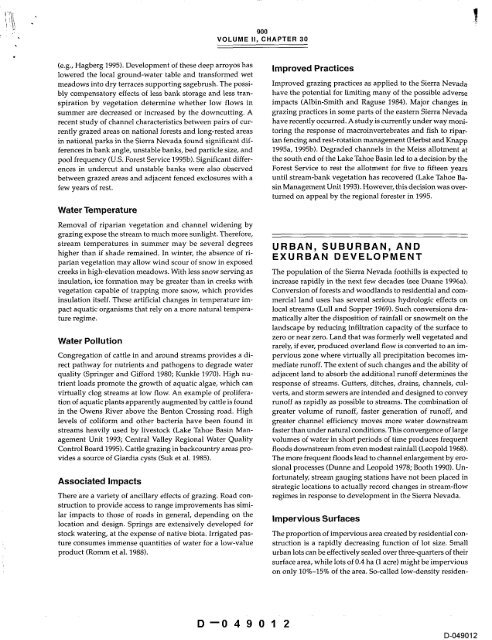D--048966 - CALFED Bay-Delta Program - State of California
D--048966 - CALFED Bay-Delta Program - State of California
D--048966 - CALFED Bay-Delta Program - State of California
Create successful ePaper yourself
Turn your PDF publications into a flip-book with our unique Google optimized e-Paper software.
900<br />
VOLUME II, CHAPTER 30<br />
(e.g., Hagberg 1995). Development <strong>of</strong> these deep arroyos has<br />
lowered the local ground-water table and transformed wet<br />
Improved Practices<br />
meadows into dry terraces supporting sagebrush. The possi- Improved grazing practices as applied to the Sierra Nevada<br />
bly compensatory effects <strong>of</strong> less bank storage and less tran-<br />
have the potential for limiting many <strong>of</strong> the possible adverse<br />
spiration by vegetation determine whether low flows in impacts (Albin-Smith and Raguse 1984). Major changes in<br />
summer are decreased or increased by the downcutting. A grazing practices in some parts <strong>of</strong> the eastern Sierra Nevada<br />
recent study <strong>of</strong> channel characteristics between pairs <strong>of</strong> cur- have recently occurred. A study is currently under way monirently<br />
grazed areas on national forests and long-rested areas toting the response <strong>of</strong> macroinvertebrates and fish to riparin<br />
national parks in the Sierra Nevada found significant dif- Jan fencing and rest-rotation management (Herbst and Knapp<br />
ferences in bank angle, unstable banks, bed particle size, and 1995a, 1995b). Degraded channels in the Meiss allotment at<br />
pool frequency (U.S. Forest Service 1995b). Significant differ-<br />
the south end <strong>of</strong> the Lake Tahoe Basin led to a decision by the<br />
ences in undercut and unstable banks were also observed Forest Service to rest the allotment for five to fifteen years<br />
between grazed areas and adjacent fenced exclosures with a until stream-bank vegetation has recovered (Lake Tahoe Bafew<br />
years <strong>of</strong> rest. sin Management Unit 1993). However, this decision was overturned<br />
on appeal by the regional forester in 1995.<br />
Water Temperature<br />
Removal <strong>of</strong> riparian vegetation and channel widening by<br />
grazing expose the stream to much more sunlight. Therefore,<br />
stream temperatures in summer may be several degrees<br />
higher than if shade remained. In winter, the absence <strong>of</strong> riparian<br />
vegetation may allow wind scour <strong>of</strong> snow in exposed<br />
U R B A N, S U B U R B A N, A N O<br />
E X U R B A N D E V E L O P M E N T<br />
creeks in high-elevation meadows. With less snow serving as The population <strong>of</strong> the Sierra Nevada foothills is expected to<br />
insulation, ice formation may be greater than in creeks with increase rapidly in the next few decades (see Duane 1996a).<br />
vegetation capable <strong>of</strong> trapping more snow, which provides Conversion <strong>of</strong> forests and woodlands to residential and corninsulation<br />
itself. These artificial changes in temperature im- mercial land uses has several serious hydrologic effects on<br />
pact aquatic organisms that rely on a more natural tempera- local streams (Lull and Sopper 1969). Such conversions drature<br />
regime, matically alter the disposition <strong>of</strong> rainfall or snowmelt on the<br />
landscape by reducing infiltration capacity <strong>of</strong> the surface to<br />
Water Pollution<br />
zero or near zero. Land that was formerly well vegetated and<br />
rarely, if ever, produced overland flow is converted to an im-<br />
Congregation <strong>of</strong> cattle in and around streams provides a di- pervious zone where virtually all precipitation becomes imrect<br />
pathway for nutrients and pathogens to degrade water mediate run<strong>of</strong>f. The extent <strong>of</strong> such changes and the ability <strong>of</strong><br />
quality (Springer and Gifford 1980; Kunkle 1970). High nu- adjacent land to absorb the additional run<strong>of</strong>f determines the<br />
trient loads promote the growth <strong>of</strong> aquatic algae, which can response <strong>of</strong> streams. Gutters, ditches, drains, channels, culvirtually<br />
clog streams at low flow. An example <strong>of</strong> prolifera- verts, and storm sewers are intended and designed to convey<br />
tion <strong>of</strong> aquatic plants apparently augmented by cattle is found run<strong>of</strong>f as rapidly as possible to streams. The combination <strong>of</strong><br />
in the Owens River above the Benton Crossing road. High greater volume <strong>of</strong> run<strong>of</strong>f, faster generation <strong>of</strong> run<strong>of</strong>f, and<br />
levels <strong>of</strong> coliform and other bacteria have been found in greater channel efficiency moves more water downstream<br />
streams heavily used by livestock (Lake Tahoe Basin Man- faster than under natural conditions. This convergence <strong>of</strong> large<br />
agement Unit 1993; Central Valley Regional Water Quality volumes <strong>of</strong> water in short periods <strong>of</strong> time produces frequent<br />
Control Board 1995). Cattle grazing in backcountry areas pro- floods downstream from even modest rainfall (Leopold 1968).<br />
vides a source <strong>of</strong> Giardia cysts (Suk et al. 1985). The more frequent floods lead to channel enlargement by erosional<br />
processes (Dunne and Leopold 1978; Booth 1990). Un-<br />
Associated Impacts<br />
fortunately, stream gauging stations have not been placed in<br />
strategic locations to actually record changes in stream-flow<br />
There are a variety <strong>of</strong> ancillary effects <strong>of</strong> grazing. Road construction<br />
to provide access to range improvements has simi-<br />
regimes in response to development in the Sierra Nevada.<br />
lar impacts to those <strong>of</strong> roads in general, depending on the<br />
location and design. Springs are extensively developed for<br />
Impervious Surfaces<br />
stock watering, at the expense <strong>of</strong> native biota. Irrigated pas- The proportion <strong>of</strong> impervious area created by residential conture<br />
consumes immense quantities <strong>of</strong> water for a low-value struction is a rapidly decreasing function <strong>of</strong> lot size. Small<br />
product (Romm et al. 1988). urban lots can be effectively sealed over three-quarters <strong>of</strong> their<br />
surface area, while lots <strong>of</strong> 0.4 ha (1 acre) might be impervious<br />
on only 10%-15% <strong>of</strong> the area. So-called low-density residen-<br />
D--04901 2<br />
D-049012

















